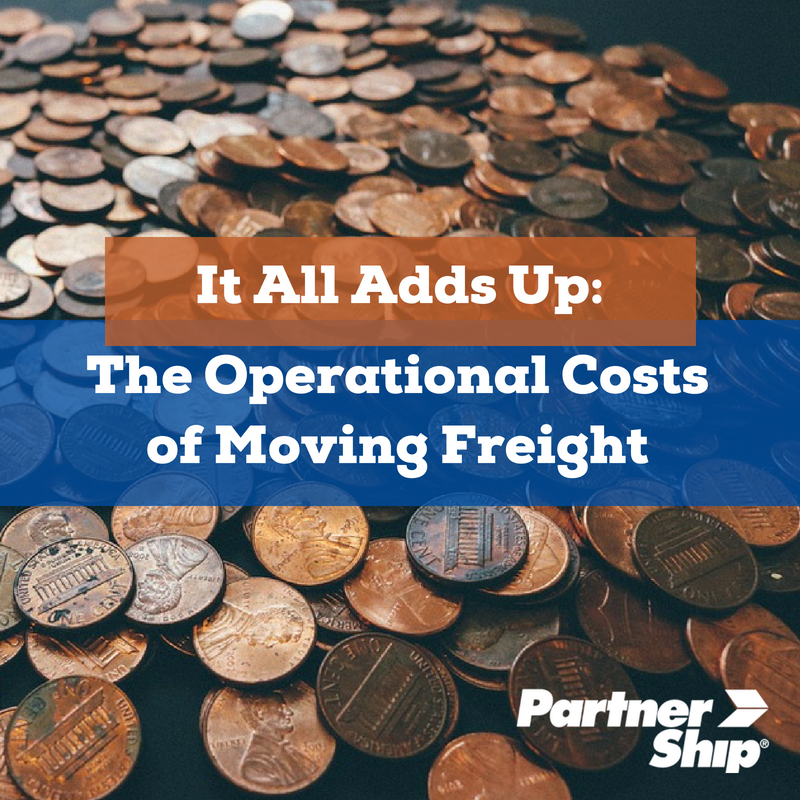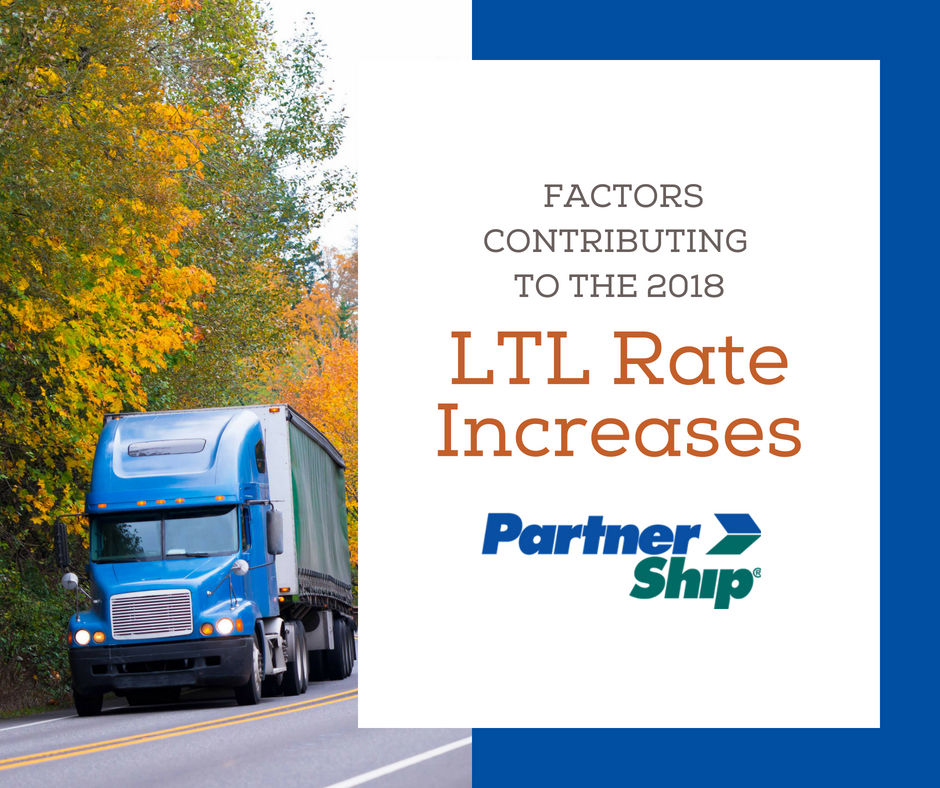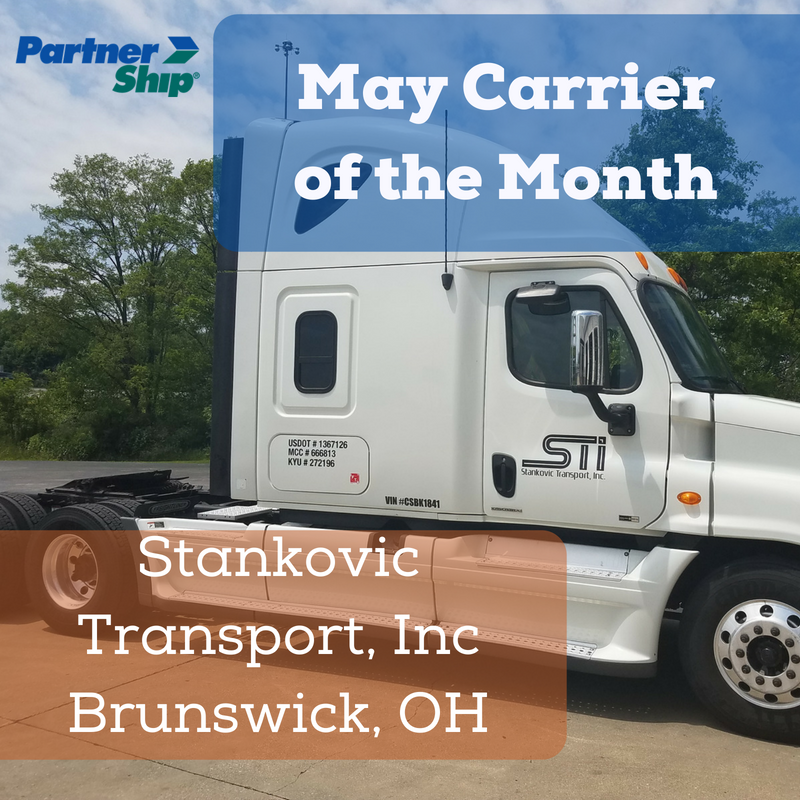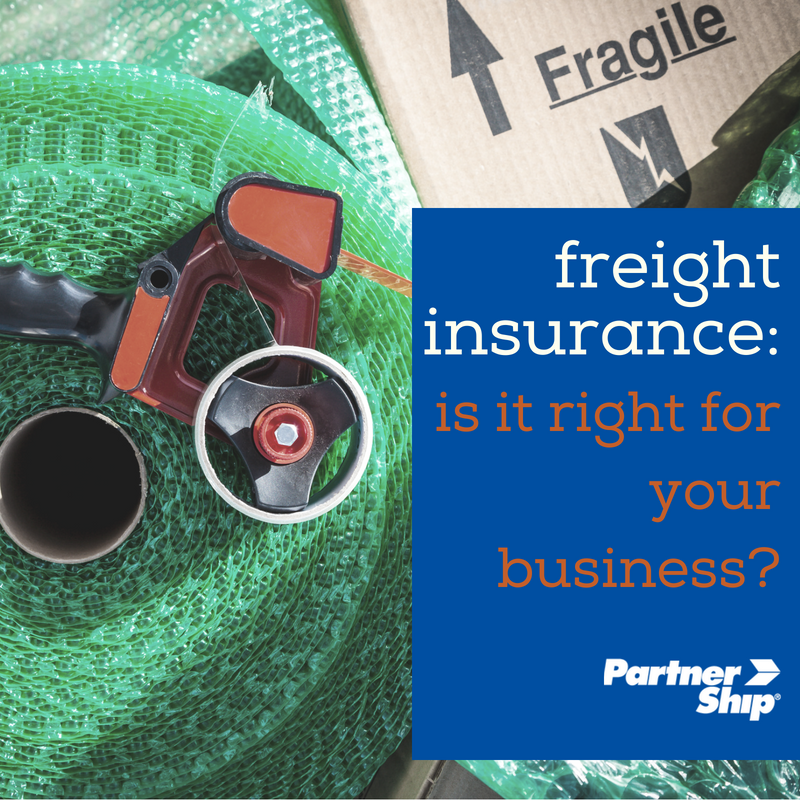the PartnerShip Connection blog
the PartnerShip Connection blog
the PartnerShip Connection blog
the PartnerShip Connection blog
the PartnerShip Connection blog
-
It All Adds Up: The Operational Costs of Moving Freight
06/22/2018 — PartnerShip

Moving freight is getting more difficult, and therefore, more expensive. If you’ve ever had “sticker shock” from a freight quote, you’re not alone. There are a lot of cost factors that go into the price you pay to move freight, so we want to explain them so you can be an informed shipper and ship smarter.
Every LTL or truckload freight shipment has fixed and variable costs that are calculated into the rate you pay to ship your freight. Let’s start by looking at the fixed costs.
Fixed Costs:- Truck Payment. Owned or leased, drivers and operators have the expense of their equipment (trucks and trailers) to consider when quoting your freight. New trucks can be leased for $1,600 to $2,500 per month and used trucks can be leased for $800 -- $1,600 per month; a new truck can be purchased for $2,250 a month (purchase price of $125,000 with 5-year financing). On average, truck payments are 16% of the cost of moving freight.
- Insurance. The FMCSA requires individual owner-operators to carry a minimum of $750,000 to $5 million in liability coverage. On average, liability and damage insurance can cost between $6,000 – $8,000 per year, with newly-granted authorities typically paying between $10,000 and $16,000 their first year. Truck insurance accounts for 5% of the cost of freight shipping.
- Driver Salary. This is the largest operating cost of moving freight. Commercial truck driver salaries are based on the distance driven, and although drivers spend a lot of time in traffic, at the dock being loaded or unloaded, etc., their operating costs are only derived from miles traveled. With an average salary of $78,200, driver pay and benefits accounts for 43% of operational costs.
- Office and Overhead. This fixed cost includes a building lease or mortgage, and includes electric, phones, internet, computers, and office support. These costs can vary widely.
- Permits and Licenses. Permits and license plate costs account for $2,300 annually, or 1% of operational costs.
Variable Costs:- Fuel. The second largest operating cost of moving freight is diesel fuel. A commercial truck can easily consume 20,000 gallons ($64,000) of diesel fuel per year, accounting for 21% of operational costs.
- Tires. Retreaded truck tires are less expensive than new tires and cost on average $250. Annual tire expense accounts for $3,600, which is roughly 2% of operational costs.
- Maintenance and Repairs. Trucks need constant maintenance and do occasionally break down. Issues with air lines and hoses, alternators, wiring, and brakes are all common in commercial trucks, and can cost $17,500 annually or 10% of operational costs.
- Meals. The truck isn’t the only part of LTL and truckload freight shipping that needs fuel! 10 meals a week at $12 each equals a meals expense of $6,500 a year.
- Tolls. With nearly 5,000 miles of toll roads in the US, chances are good that your freight will be traversing at least one of them, and this will be factored in your cost. For example, a load moving from Chicago to Baltimore will encounter toll roads in Illinois, Indiana, Ohio, and Pennsylvania, costing $225.75. Sometimes a carrier can avoid toll roads, but this will frequently increase the number of miles driven, which also increases your cost. On average, tolls add $2,500 a year, 2% of the total cost of freight shipping.
- Coffee. Did you know that truck stops sell more coffee than convenience stores? The average commercial truck driver spends more than $600 a year on coffee. Its effect on cost is negligible but we thought it was interesting!
- Profit. Remember, freight carriers are in business to make a profit. Owners, operators and drivers are funding their kids’ education or dance lessons, paying their mortgages, and buying food and necessities, so please don’t expect them to move your freight for free.
There are also many miscellaneous items that can factor into overall freight costs:- Electronic Logging Devices (ELD), which have decreased driver productivity approximately 15%. When drivers spend less time driving, transit times increase and drivers move fewer loads, which pushes costs up.
- Telematics services, such as vehicle and trailer GPS tracking.
- Driver turnover; not just the cost of recruiting and training, but also the opportunity cost of empty trucks not hauling freight because they have no drivers.
- Finding loads to move can take up a sizable chunk of every day. Every hour spent not driving loaded miles is an hour a driver isn’t making money.
The bottom line is that a lot of factors go into the cost you pay for LTL or truckload freight shipping. The costs listed here are conservative and are probably on the low end, so your costs may be higher.
The struggle is real: moving freight is getting more difficult and more expensive. By shedding light on the costs that go into each and every LTL or truckload freight move, we hope that you’re better informed so you don’t experience “sticker shock” next time you get a freight quote. If you find yourself battling rising freight costs and need some help, contact the freight shipping experts at PartnerShip. We have significant experience in both the LTL and full truckload markets and can help you ship smarter so you can stay competitive.

Click to read more... -
Factors Contributing to the 2018 LTL Rate Increases
06/19/2018 — Leah Palnik

LTL freight rate increases are unavoidable. And in this current tight capacity market, it’s no surprise that many carriers have taken their general rate increases (GRIs) earlier than in previous years. Just like in the truckload market, costs are been driven up by the ELD mandate, the driver shortage, and hours of service (HOS) rules. Coupled with the strong U.S. economy, freight demand is surging and straining the market.
Along with the tight capacity market, trends towards shorter supply chains and smaller, lighter loads have led to more demand for LTL services. The rise of ecommerce has played a large role in the increased demand. Products that consumers never would have dreamed of ordering online years ago, like furniture, have now become commonplace for ecommerce. However, these types of shipments are less desirable for carriers. With more deliveries being made to more remote areas without backhaul opportunities, the costs are significantly higher for them.
With the driver shortage, it is easier for carriers to find and recruit LTL drivers, compared to truckload. They are more appealing jobs, with shorter lengths of hauls and less time away from home and families. However, there are fewer LTL carriers entering the market when compared to truckload. The complex networks of terminals that LTL carriers rely on are much more difficult to establish, making it a significant barrier to entry.
With all of those factors to contend with, LTL carriers have been announcing their GRIs throughout the first half of 2018.
- FedEx Freight: 4.9% effective January 1
- YRC Freight: 5.9% effective February 19
- XPO: 5.9% effective March 5
- UPS Freight: 5.9% effective March 26
- ABF: 5.9% effective April 16
- Estes: 5.9% effective May 7
- Old Dominion: 4.9% effective June 4
Rates aren’t the only thing on the rise. Many carriers are charging more for accessorials like inside delivery or Saturday delivery. Carriers are also implementing tools and technology that help them determine what types of freight are profitable and which ones aren’t – and charging accordingly. Dimensional pricing is one example of this. Many carriers have invested in dimensioning machines, which calculate the amount of space a shipment will need in the truck, leading to less dependency on the National Motor Freight Classification (NMFC) system.
As with any announced rate increases, the important thing to remember is that the averages may not reflect the actual increases you’ll see in your freight bills. Depending on the lane and shipment characteristics like weight or class, the increase could be significantly more.
To determine what you can expect and what you can do to offset the rising costs, start by taking a look at the increases for your typical lanes. That will give you a better idea of what cost increases you can budget for, rather than relying solely on the reported averages. Then determine ways to reduce those costs. Consider working with a freight broker, to benefit from their industry expertise. A quality broker will have the knowledge to help you navigate the market and will be able to find solutions that can help to reduce your costs.
PartnerShip can help you ship smarter. For a competitive rate on your next LTL shipment, get a free quote!

Click to read more... -
PartnerShip Loves Our Carriers! Here is Our May Carrier of the Month
06/15/2018 — PartnerShip

We love our carriers, because we know that if it weren’t for our top-quality freight carrier partners, our customers couldn’t ship and receive their freight in a timely and cost-effective way. Our carriers help us help our customers ship smarter.
Our May Carrier of the Month is Stankovic Transport, Inc. of Brunswick, OH! They have been in business since 2009 with more than 50 owned and operated trucks and trailers.
The PartnerShip Carrier of the Month program recognizes carriers that go above and beyond in helping our customers ship and receive their freight. Our truckload team members nominate carriers that provide outstanding service in communication, reliability, and on-time performance.
For being our May 2018 Carrier of the Month, we’re providing Stankovic Transport lunch for the whole office and a framed certificate to proudly hang on their wall. The gestures may be small but our appreciation is huge!
Interested in becoming a PartnerShip carrier? We match our freight carriers’ needs with our available customer loads because we understand that your success depends on your truck being full. If you’re looking for a backhaul load or shipments to fill daily or weekly runs, let us know where your trucks are and we’ll match you with our shippers’ loads. If your wheels aren’t turning, you’re not earning.
Click to read more... -
Freight Insurance: Is It Right For Your Business?
06/13/2018 — Jen Deming

Let's face it: ship happens. Even though many shippers prepare for the worst and do their very best to protect their freight, loss and damage are an unfortunate reality of the business. Freight insurance is a vital tool that business owners can use to offset the costs of freight damage and limited carrier liability. Unfortunately for many shippers, freight insurance coverage can be complicated to understand and is often misunderstood. How do you know if you should be using freight insurance?
First and foremost, it is important to understand the difference between freight insurance and carrier liability. Carrier liability is an industry term used to describe the responsibility of the carrier as it relates to losses, damages, and delivery delays to compensate the shipper. Of course, exceptions are put in place by the carrier, such as whether the damage or loss is a result from the action of a shipper (ex. improper packaging), an act of God, public authority, or due to the inherent nature of the goods.
It is the responsibility of the shipper to prove that the damage or loss of their shipment is a direct result of the carrier's own negligence. To accomplish this, it is important to take pictures of your packaged freight before the pick-up is completed, and inspected thoroughly once it is delivered. Any damage or loss MUST be noted on the delivery receipt. If your shipment does not encounter any issues, it is important to properly follow the claim filing process within 9 months of the delivery date. You have even less time with a concealed claim. At 5 days max, it is extra crucial to get the process moving along promptly.
But here's the thing about carrier liability: even if you can win a claim against the carrier, the payout often doesn't cover the total cost or value of your freight shipment. Every carrier has an established payout amount, usually per pound and depending on the fright class and limit of liability. Additionally, there are many exceptions and limitations as well as restricted types of freight that are compensated for even less, such as some electronics, artwork, and furniture types. The good news? Freight insurance does not require the shipper to prove that the carrier was at fault for the damage or loss, simply that the damage occurred. It's a great way to protect you and your customers and to be sure your shipment can be covered for its full value. Freight insurance is often offered by third-party insurers at a fee on top of your carrier rate for transit. So how do you know if it's worth the extra cost?
Fragile Shipments
If you are shipping products that are fragile and may break easily, it's a good idea to seek out additional freight coverage. Most carriers have their best interest in mind, and only offer limited coverage on these types of shipments, knowing there is a higher potential that they may break in transit. So if there is damage, it's unlikely you will get the full value of what has been lost. Proper packaging can help mitigate the likeliness that damage may occur, but the loading and unloading process doesn't always go as planned. Damage can occur at pick-up and destination delivery, as well as the many times your freight may be loaded at various terminals throughout transit. There are carriers who specialize in the transport of fragile shipments, commonly referred to as white glove service providers, but this alternative can be costly and still may have limited coverage. Freight coverage purchased through an insurance provider is typically based on the declared value of your freight and can help give shippers peace of mind.
High Value Freight
Similar to those who ship fragile products, businesses who are transporting high-value goods need to be mindful of how much coverage they receive through limited carrier liability. Just because your shipment isn't particularly breakable, doesn't mean your freight is protected in the event that it can go missing or may be delayed. While unlikely, it's always a good idea to have a plan that will cover your back, and your bottom line. Carriers typically pay out by the pound. For example, it's not uncommon to see a pay out of $0.25 per lb or even less on restricted items for less-than-truckload, with a max cap of $100,000 per truckload. With many types of freight insurance coverage through different providers, the total value of the shipment is covered, despite whether the carrier accepts responsibility or not. Of course, it's always crucial that shippers are diligent and fully understand the terms of their third-party insurance coverage, no matter which provider they go with.
Inbound Shipments
Another important consideration for businesses concerns their supply order or inbound shipments. Typically, a vendor will determine this portion of the shipping process- choosing carrier, service type, and rate. Taking control of your inbound shipping is crucial, both in reducing costs and selecting the carrier that best suits your needs. But, apart from that, how can you better protect your inbound shipments against damage during transit, especially when as the receiver, you aren't even there to check on proper packaging and material handling? Enrolling in an inbound freight insurance coverage plan can help mitigate the cost of damage and help business owners take back control on their inbound freight.
It's safe to say that if you are shipping high value freight, fragile products, or receive inbound shipments, it is crucial to take a look at supplemental freight insurance options. At PartnerShip, we want to offer better coverage than the typical limited liability offered by the carrier because "one size fits all" just doesn't cut it. The shipping experts at PartnerShip can help you decrease your risk and increase your peace of mind. Contact us at 800-599-2902 or email sales@PartnerShip.com for more information about freight insurance, or get a quote today.

Click to read more... -
Local Girl Scout Troop Brings An Exciting New Game to Their School
06/07/2018 — Leah Palnik

If you’ve never heard of gaga ball, you’re not alone. But to millions of kids around the world, it’s the hottest game on the playground right now. The game, played in an octagon pit, is simple. Similar to dodgeball, the goal is to be the last one standing and players use a soft foam ball to knock out their opponents.
Gaga ball is a fast paced game that keeps kids on their toes. Once in the pit, players hit the ball with one open or closed hand without throwing, carrying, or dribbling. Players are out if the ball hits them below the knee at any time.
The best part of the game is how inclusive it is. You don’t have to be the tallest, the strongest, or the most athletic to join in the fun. The games also have a fast turnover so everyone can have a turn, and even after getting knocked out, it’s not long before you can jump back in again.
That’s why when a local Girl Scout troop contacted PartnerShip about helping to sponsor their gaga pit project, it was an easy decision. Supporting our community is important to us and providing a place where kids of all abilities can come together is a great way to do it.
The Girl Scouts of Troop 168 in Westlake, Ohio saw a need in their community for something that would bring kids together and make everyone feel included. Girl Scout Tina Cirincione said she first learned of gaga ball from camp and knew it would be perfect for their Silver Award Project. From there Tina and her troop members began developing a plan. They researched possible locations and reached out to members of the community to put their plan into action.
By working with the city of Westlake and Westlake City Schools, Troop 168 selected the grounds of Dover Intermediate School to build their gaga pit. This is the first gaga pit in Westlake – a huge accomplishment for the girls and their school.
On a beautiful spring day, the gaga pit officially opened. At the site on Dover Intermediate School grounds, the Girl Scout troop invited everyone who supported their project to join them as they celebrated this addition to their community. Members of Westlake City Schools, Mayor Dennis M. Clough, and other community leaders joined the troop to celebrate.
The members of Girl Scout Troop 168 were beaming with pride while Mayor Clough congratulated them on a job well done. Then it was time to jump in! The girls played the inaugural game and it was immediately apparent how much fun they were having. Even the adults played a round, proving it truly is a game for everyone to enjoy.
Now that the gaga pit is open to the community and in a location that makes it easily accessible to kids in the area, it’s sure to attract a lot of activity. There aren’t many games that bring kids together the way that gaga ball does. Most organized sports require a certain skill level or will separate boys and girls. The way gaga ball is played allows for kids of all different backgrounds and skills to play together. Sports play a very important role in developing self-esteem, improving social skills, and staying active so having a game that can include kids that may otherwise miss out is a huge win.
Girl Scout Troop 168 did an amazing job on this project. From gathering support, to making a plan and building the gaga pit, they put in a great deal of hard work. What Girl Scout Troop 168 did for their peers can serve as a lesson for all of us. Supporting your community in a small way can make a big difference.
Click to read more...




